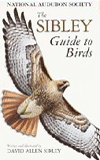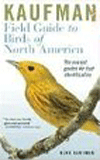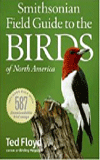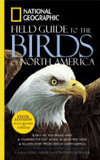A Non-Birder's Guide to Bird Field Guides |
We’re both birders. We came to bird photography from birding. When we see a bird species, our common inclination is to identify it, to study it, not immediately photograph it.
Why study birds? Why learn to identify birds? Well, first there are the practical reasons. In Alaska, we tell the story of University of Alaska Museum curator Dan Gibson getting a call from a distraught citizen. She had found an injured black and white bird, that she’d identified as a Common Loon, and wanted to know what to do. Dan told her to partly fill a bathtub with water, put the bird in it, and he’d be by that evening. The lady called an hour later, telling him the bird wasn’t doing so well. Dan agreed to come by immediately. But by the time he got there, the Hairy Woodpecker had drowned. Getting a bird ID right really can matter.
More practically, perhaps, it will make you a better bird photographer. To borrow a sports analogy from Pete Dunne, if you’re after a photo of an (American) football quarterback throwing a long pass, and you know it is third and fifteen, you know you’ve got a pretty good opportunity. If you know it’s fourth and fifteen, you know not to bother. It’s no different with birds. If you know what species you’ve got in front of your lens, you have a better idea what it is likely to do next and you’ve got a much better chance of getting that shot you've envisioned.
There are about 800 species of birds that appear fairly regularly in North America. But few regions regularly have more than 300 species. It’s going to take you a while to learn which species is in front of you, and what it’s likely to do. The tools you use to learn the species and their behavior matter. What we’re going to do is look at four common bird identification books, and give you our two perspectives on each of them.
There are a number of features to look for in a bird guide:
- The quality of the drawings or photographs, including drawings of the birds in alternate plumages (i.e., juvenile, adult, breeding, non-breeding).
- The quality, accuracy and readability of the range maps for each species; range maps are a key to identifying species and inaccuracies can be a real problem.
- The number of species described; no guide can be expected to have all of the Asian vagrants that appear in the Aleutian Islands or Carribean species in southern Florida, but of the 800 or so species that are seen regularly, how many are described and how well.
- The organization and ease of use a guide offers, including whether and how the birds are organized, the quality of the introductory materials, the presence of a quick index, whether there are index tabs and the other little things that make a guide easier to use.
With those features in mind, here's our takes on four of the most popular bird identification guides.
|
|
National Geographic Field Guide to Birds, Fifth Edition Author: Jon L. Dunn and Jonathan AlderferPaperback: 504 pages Publisher: National Geographic; 5th edition (November 7, 2006) ISBN: 0792253140 |
| Jim's Comments | Overall, the best guide. The introductory materials aren't as good as the Smithsonian guide, and the drawings aren't as good as Sibley's, but the range maps are quite good and the treatment of accidental species (unusual birds and rarities) is outstanding. It's not quite as good as Kaufman at pointing out key field marks on the birds, but the text descriptions of the field marks are a decent substitute. It's portable enough to carry in the field and complete enough to carry in the car. |
| Richard's Comments | This has been a favorite of mine since it came out in 1983, and I've had many copies in various editions. Each new edition corrects issues in previous versions, sometimes making small corrections to individual drawings; at other times replacing entire pages with more accurate paintings. One of the two guides I always have in my car, and my first choice when I feel like carrying a field guide while actively looking for birds.
I like the complete coverage of North America in a single volume, making the same guide useful wherever I go in the U.S. or Canada. It is a little larger than most field guides but still small enough to carry about. Range maps are a little small but accurate and readable in the field. A favorite feature for me is the four page spread of female hawks in flight as seen from below, but I wish that Short-tailed Hawk was included in these four pages since it now occurs regularly in a few places in Arizona. Quality of the illustrations varies, with different artists handling different families of birds. I like the hawk, gull, and shorebird paintings a lot; but the sparrows have always been weak and looked "puffed up" and unnatural. |
 |
The Sibley Guide to Birds
David Allen Sibley |
| Richard's Comments | A must-have for any serious birder. Sibley's skills as both a field birder and artist have been put to good use in this large volume. Sibley's paintings show an economy of style that still captures the essence of a bird. There is also value in having a single artist paint all the birds for a uniform style that is lacking in some other field guides. I espeically like his flight illustrations for every species - something unique to his field guide. I find the original volume covering all North American birds is too large to carry about in the field, so get the smaller Eastern or Western volume if you want to carry it with you. I keep the small western volume in my car at all times, and the larger version in my birding library. |
| Jim's Comments | For intermediate and advanced birders, or for serious beginners, this is a nearly perfect guide. In particular, I found the pages showing all of the flycatchers on one page, or all of the woodpeckers, or all of the small gulls, to be exceptionally well done. For the treatment of individual species, well, in most cases, you will only find better drawings in the specialty books. I'd be proud to hang any of Sibley's 6,000 or more watercolors depicted in this book on my wall at home.
It's larger than a traditional field guide, but not so large that you can't lug it along in the field. Other reviews imply it's the size of an unabridged encyclopedia; in fact, it's about half again the size of the National Geographic. The volume has been published in Eastern and Western Region editions, which are more standard sized. |
 |
Kaufman Field Guide to Birds of North America
Kenn Kaufmann |
| Jim's Comments | Kenn Kaufman is a legend among birders. At age 16, completely on his own, he did a Big Year - an effort to see as many bird species as possible January 1 to December 31. Birder parents tremble at the story. Kaufman hitchiked across the country numerous times, and to Alaska twice.
He's now Professor Kenn Kaufman. And a terrific guy. Alas, I don't think much of his Guide. Birds are organized in a non-standard way, which makes it a bad way to learn. If you try to find a bird in any of the other three guides we discuss here, the bird may well be in a different place, because they are all in taxonomic order. The illustrations are digitially enhanced photographs, and, frankly, they are not very good. Only one plumage is shown, and only one angle. There are no field marks labeled, and the species' descriptions are terse to the point of being incomplete. This is the only Guide of the four we discuss I don't take into the field. |
| Richard's Comments | I agree with Jim's comments about Kenn Kaufman. I also agree with his views on Kaufman's field guide. I consider it a "noble effort" at creating a new style of field guide aimed primarily at beginning birders that just misses the mark. I find the pages visually cluttered, with too many species crammed on each page. I find the varying colored page backgrounds distracting. The blacks and whites of plumage also suffer in the reproduction and tend to be blocked up without texture and detail. In its favor: the color coding to major sections on the page edges of the closed book; the two pages devoted to Domestic and feral waterfowl (which should be required reading for all novice birders); the boundary line map between Black-capped and Carolina Chickadees (having lived right on this boundary in NJ I know what a nightmare this is!) |
 |
Smithsonian Field Guide to the Birds of North America Ted Floyd |
| Richard's Comments | This is the best of the new breed of photo-based field guides. Image quality is generally good, although the background can be a problem in some photos making the bird harder to see well. Information and range maps are up-to-date. There's a lot of material packed in the pages of this guide. The DVD of bird calls is a very nice feature that makes the price of the guide a great bargain.
If you insist on a photo-based guide instead of the demonstrably better guides using paintings this is the one to get. |
| Jim's Comments | This is the Guide I usually recommend to beginning birders. The author is the editor of Birding Magazine, published by the American Birding Association. The introductory materials, explaining the parts of bird and approaches to learning them, are exceptionally good. The bird illustrations are photographs and very good, if not as good as National Geographic or Sibley. The descriptions are good, and offer bullet points for key field marks and cues. The descriptions of the birds' calls and songs are the best of the four. There are fewer views of each species, and some of the photos aren't as detailed or revealing as you might like. The Guide ships with a DVD that offers more than 500 bird songs and calls in MP3 format. I really must get around to moving them to my iPod. |
Bottom Line Recommendations
Jim & Richard: National Geographic for beginners, with Smithsonian a close second. Sibley for intermediate and advanced birders.
Comments on NPN bird photography articles? Send them to the editor. NPN members may also log in and leave their comments below.
Jim DeWitt lives in Alaska. He has camped, hiked, skied, fished and photographed in the Pacific Northwest for 46 years. Richard Ditch lives in Arizona and he's been a photographer and a birder since the early 1970’s. More of his work can be seen at his website, www.richditch.com.
